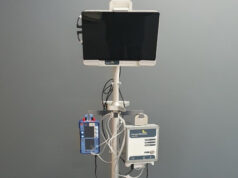Researchers have used cardiac magnetic resonance (CMR) imaging for the first time to demonstrate the mechanistic improvements in cardiac contractility consequent to cardiac resynchronisation therapy (CRT), as well as the relative safety of the approach. Presenting the findings this week at an oral abstract session at the Heart Rhythm Congress (HRC 2019; 6–9 October, Birmingham, UK), Aaron K Koshy (University of Leeds, Leeds, UK) added that varying atrial pacing rates appear to have unique effects on cardiac response patients, suggesting that tailored programming may be of benefit.
CRT is a routine treatment for patients with heart failure with reduced ejection fraction, with conduction delay to improve symptoms and prognosis in patients. Technological advancements both in imaging CMR and devices (sophisticated MRI-conditional modes) enable investigation of the haemodynamic response to CRT over a range of heart rates.
Koshy outlined: “We are trying to understand the basic response to CRT in terms of mechanics of cardiac response, and we are using cardiac MRI as well. It is a simple physiological process—the concept is that, in healthy individuals, when you increase the heart rate, you often get an increase in contractility. Our team have [previously] shown … when you increase the heart rate, patients who have heart failure do not seem to have the same effect. They seem to have a static contractility, whereby it is not really changing with heart rate. Our work wants to look at this further and utilise the power of cardiac MRI … in volumetric assessment and some functional assessment.”
The study looked at the safety of the method, and what it added to the understanding of the acute effects in these patients. “It is not a particularly new idea; we have been hypothesising this for a couple of years. MRI devices are quite easily available … so why don’t we try and put them [patients] in an MRI scanner and, if so, what will we find out?”
Patients with a CRT-D device were enrolled from heart failure clinics at Leeds General Infirmary, Leeds (UK)—“Obviously, we are focusing on individuals that have MRI-compatible devices.” After an MRI safety assessment, a baseline device interrogation was conducted by a cardiac physiologist.
“We are using one of the older forms of scanning techniques, retrofitted with updated sequencing modifications … and using what is known as a gradient echo scan, to reduce the effects of some of the classic artefact problems you encounter with MRI scans and CRT devices.”
Left ventricular (LV) volumes and systolic blood pressure were measured at baseline, as well as at a further seven different heart rate values—75, 90, 100, 115, 125, 130 and 140 beats per min (bpm)—in a randomised order. Patients’ CRTs were also randomised to be either enabled or disabled at the beginning. A post-scan device pacemaker check was then conducted, and patients returned a week or so later for the same protocol, but with the CRT placed in the opposite mode. Controls were healthy patients who underwent the same methodology.
To date, the crossover study has analysed 17 paired patients, and nine controls. Post-scan battery voltage from baseline was –2.92 with CRT active and 2.9% when disabled (p=nonsignificant). Overall lead impedance change was –0.1% and 0.91% (p= nonsignificant) in patients with CRT active and disabled, respectively. No statistical difference was found between CRT modes, and no patients experienced symptoms related to scanning or device failure.
Contractility increased across heart rates when CRT is active and remains relatively static when CRT is disabled. At the peak heart rate of 140bpm, mean contractility was 2.6mmHg/mL when CRT was active, compared with 1.98mmHg/mL when disabled (p=0.05). Other heart rates failed to reach statistical significance in terms of contractility when alternating CRT modes.
Left ventricular ejection fraction (LVEF) reduces with increased atrial pacing, in keeping with cardiac physiology. Mean LVEF was 26.2% when CRT was active versus 19.3% when disabled (p<0.01). Furthermore, at 140bpm LVEF was 19.3% with CRT active versus 13.3% when disabled (p<0.01).
“It is no surprise when you look at the left ventricular ejection fraction, it is consistently higher when CRT is active, and that is really what we are hoping for with CRT in general.”
Left ventricular cardiac output (LVCO) appears to have a bell-shaped curve across heart rates in heart failure patients which widens when CRT is active—“An interesting picture,” according to Koshy. “When CRT is disabled, you are getting an increase in cardiac output when you increase the heart rate. That is not much of a surprise. But after 100bpm, it really seems to fall off a cliff and dramatically decrease. However, when CRT is activated, there seems to be almost a preservation factor, or a delay in the drop off, until 125 bpm.” Mean LVCO at 125bpm was 5,749 mL/min with CRT active versus 4,254 mL/min when CRT was disabled (p<0.01). Similarly, at 140bpm, LVCO was 4,994 mL/min with CRT active versus 3,241 mL/min when CRT was disabled (p=0.02).
Mean SBP across the HR range was 127.8mmHg (while CRT was active) versus 117.5mmHg (CRT disabled, p<0.0001).
Summing up, Koshy said: “In our carefully chosen cohort, it seems relatively safe to scan patients with CRT devices, importantly while CRT is active. Contractility seems to be quite static in heart failure patients, but when you activate CRT it seems to change that pattern, potentially partially normalising it. What we want to look into further is how increasing the heart rate in this way seems to regress or reduce ejection fraction.”
Other next steps for the research team, he said, include further MRI work on phantom models and artefact mitigation, and—“the real pipe dream for all of us”—the incorporation of MR spectroscopy.












